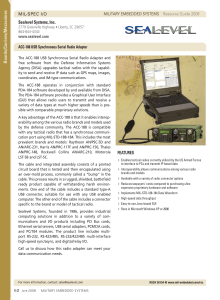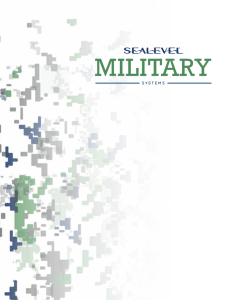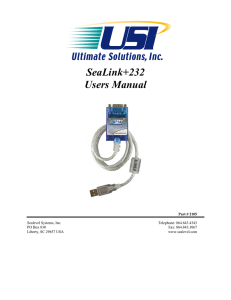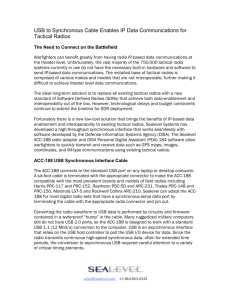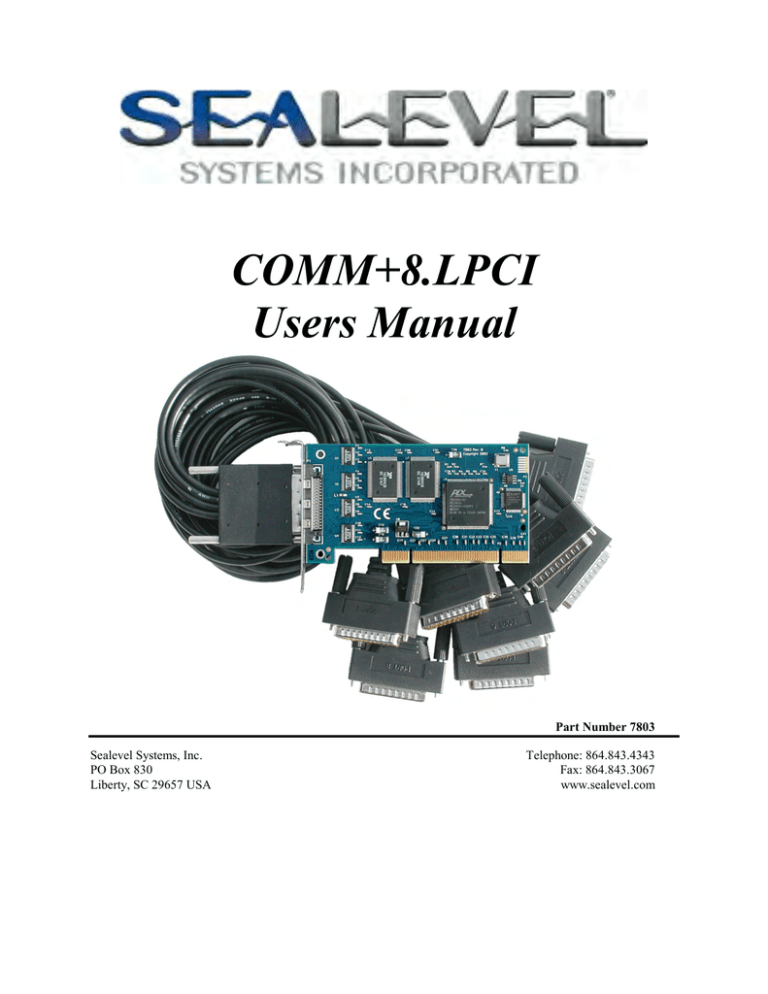
COMM+8.LPCI
Users Manual
Part Number 7803
Sealevel Systems, Inc.
PO Box 830
Liberty, SC 29657 USA
Telephone: 864.843.4343
Fax: 864.843.3067
www.sealevel.com
Contents
INTRODUCTION ........................................................................................................................ 1
OVERVIEW .............................................................................................................................................. 1
WHAT IS INCLUDED ................................................................................................................................. 1
CARD SETUP ............................................................................................................................ 2
ADDRESS AND IRQ SELECTION ............................................................................................................... 2
BAUD RATES AND OSCILLATOR VALUE ................................................................................................... 2
INSTALLATION ......................................................................................................................... 3
OPERATING SYSTEM INSTALLATION ........................................................................................................ 3
Windows 95/98/ME/NT/2000/XP....................................................................................................... 3
Linux ................................................................................................................................................... 3
QNX .................................................................................................................................................... 3
PHYSICAL INSTALLATION ........................................................................................................................ 3
TECHNICAL DESCRIPTION ...................................................................................................... 4
CONNECTOR PIN ASSIGNMENTS .............................................................................................................. 4
DB-25 (RS-232 DTE) (DB-25 Male) .............................................................................................. 4
DB-68 (Micro MDB-68 Female) ..................................................................................................... 4
SPECIFICATIONS ...................................................................................................................... 5
ENVIRONMENTAL SPECIFICATIONS .......................................................................................................... 5
POWER CONSUMPTION ............................................................................................................................ 5
PHYSICAL DIMENSIONS ........................................................................................................................... 5
APPENDIX A - TROUBLESHOOTING ........................................................................................ 6
APPENDIX B - HOW TO GET ASSISTANCE .............................................................................. 7
APPENDIX C - ELECTRICAL INTERFACE ................................................................................ 8
RS-232.................................................................................................................................................... 8
APPENDIX D - ASYNCHRONOUS COMMUNICATIONS .............................................................. 9
APPENDIX E - SILK-SCREEN ................................................................................................. 10
APPENDIX F - COMPLIANCE NOTICES .................................................................................. 11
FEDERAL COMMUNICATIONS COMMISSION STATEMENT ....................................................................... 11
EMC DIRECTIVE STATEMENT ............................................................................................................... 11
WARRANTY ............................................................................................................................ 12
©Sealevel Systems, Inc.
SL9067 Revision 7/2006
Sealevel Systems, Incorporated. All rights reserved.
Introduction
Introduction
Overview
The COMM+8.LPCI provides eight RS-232 ports from a single PCI slot. The board meets the requirements for the
MD1 "Low Profile" specification as defined by PCISIG in PCI 2.2 "Low Profile Addendum." The
COMM+8.LPCI also features Universal Bus (3.3 and 5.0V) operation.
The COMM+8.LPCI ships with a Low Profile PCI bracket that will only work in a Low Profile PCI slot. If you
need a standard size PCI bracket, please order Item# 7803S.
What is Included
The COMM+8.LPCI is shipped with the following items. If any of these items is missing or damaged, contact the
supplier.
•
•
•
COMM+8.LPCI Serial I/O Adapter
Item# 7803 ships with a Low Profile PCI bracket
Item# 7803S ships with a standard size PCI bracket
Micro MDB-68 to Eight Connector Fan Out Cable
Item# CA202, MDB-68 to eight DB-25M fan out cable, ships with Item# 7803
Item# CA231, MDB-68 to eight DB-9M fan out cable, ships with Item# 7803-DB9
Sealevel Software CD
Sealevel Systems COMM+8.LPCI
Page 1
Card Setup
Card Setup
Address and IRQ selection
The COMM+8.LPCI is automatically assigned I/O addresses and IRQs by your motherboard BIOS or by a ‘Plug-nPlay’ Operating System. Adding or removing other hardware or moving the adapter to another slot may change the
assignment of I/O addresses and IRQs.
Baud Rates and Oscillator value
The following table shows some common data rates and the rates you should choose to achieve them when using the
COMM+8.LPCI. If the O/S of choice is Windows 95/98/ME/2000/NT/XP, the oscillator value (7.3728 MHz) will
be automatically entered into the ‘Advanced Tab’ on 95/98/Me/2000/XP Device Manager applet. When using
Windows NT, the ‘Advanced Ports’ applet in the Control Panel should be launched and the oscillator value may be
entered in the ‘Advanced’ tab. When using any other OS (i.e. Linux, or QNX) the following tables should be used.
For this Data Rate
1200 bps
2400 bps
4800 bps
9600 bps
19.2K bps
57.6 K bps
115.2 K bps
230.4K bps
460.8K bps
Choose this Data Rate
300 bps
600 bps
1200 bps
2400 bps
4800 bps
14.4K bps
28.8K bps
57.6 K bps
115.2 K bps
If your communications package allows the use of Baud rate divisors, choose the appropriate divisor from the
following table:
For this Data Rate
1200 bps
2400 bps
4800 bps
9600 bps
19.2K bps
38.4K bps
57.6K bps
115.2K bps
230.4K bps
460.8K bps
Sealevel Systems COMM+8.LPCI
Choose this Divisor
384
192
96
48
24
12
8
4
2
1
Page 2
Installation
Installation
Operating System Installation
Windows 95/98/ME/NT/2000/XP
Do not install the Adapter in the machine until the software has been fully installed.
1.
Start Windows.
2.
Insert the Sealevel Systems CD in to your CD drive.
3.
If ‘Auto-Start’ is enabled for this drive the software will automatically launch. Otherwise, point your
browser to the ‘Index.htm’ on the root of the CD
4.
Select ‘Install Software’.
5.
Select the part number for your adapter from the listing.
6.
Select ‘Windows 95/98/ME/NT/2000/XP’ then (depending on the OS version) select the ‘Run from current
location’ or ‘Open’ option. Follow the information presented on the screens that follow.
Linux
Refer to D:\software\seacom\Other\Linux\Linux.Serial.README (where D: = your CDROM driver letter) found
on the Sealevel Systems CD. This file contains valuable information on installing your adapter in the various Linux
releases. Also in this sub-directory is the LinuxSerialHOWTO. This series of files explains typical Linux serial
implementations, as well as informing the user to Linux syntax and preferred practices.
QNX
Refer to D:\software\seacom\Other\QNX6\Install.readme (where D: = your CDROM driver letter) found on the
Sealevel Systems CD. This file contains valuable information on installing your adapter in the QNX6 Neutrino OS,
as well as the files required to ensure a flawless implementation. Also provided on the Sealevel Systems CD are
implementation instructions for QNX4. These are found in D:\software\seacom\Other\QNX4\QNX_COM.txt.
Physical Installation
The adapter can be installed in any PCI (5V or 3.3 V) expansion slot.
Do not install the Adapter in the machine until the software has been fully installed.
1.
Turn off PC power. Disconnect the power cord.
2.
Remove the PC case cover.
3.
Locate an available PCI slot and remove the blank metal slot cover.
4.
Gently insert the PCI adapter into the slot. Make sure that the adapter is seated properly.
5.
Replace the screw. (This is required to ensure FCC Part 15 compliance.)
6.
Replace the cover.
7.
Install the cable (CA-199)
8.
Connect the power cord
Installation is finished.
Sealevel Systems COMM+8.LPCI
Page 3
Technical Description
Technical Description
The COMM+8.LPCI provides eight RS-232 ports from a single PCI slot. The board meets the requirements for the
MD1 "Low Profile" specification as defined by PCISIG in PCI 2.2 "Low Profile Addendum." The
COMM+8.LPCI also features Universal Bus (3.3 and 5.0V) operation.
The COMM+8.LPCI utilizes the 16C864 UART. This chip features programmable baud rates, data format,
interrupt control and industry leading 128-byte transmit and receive FIFOs.
Connector Pin Assignments
DB-25 (RS-232 DTE)
Signal
GND
TD
RTS
DTR
RD
CTS
DSR
DCD
RI
(DB-25 Male)
Name
Ground
Transmit Data
Request To Send
Data Terminal Ready
Receive Data
Clear To Send
Data Set Ready
Data Carrier Detect
Ring Indicator
Pin #
7
2
4
20
3
5
6
8
22
Mode
Output
Output
Output
Input
Input
Input
Input
Input
Technical Note: Please terminate any control signals that are not going to be used. The most common way to do this
is connect RTS to CTS and RI. Also, connect DCD to DTR and DSR. Terminating these pins, if not used, will help
insure you get the best performance from your adapter.
DB-68 (Micro MDB-68 Female)
Port #
TD
RI
DCD
DTR
RTS
DSR
RD
CTS
GND
Sealevel Systems COMM+8.LPCI
1
1
2
3
4
5
6
7
8
17
2
9
10
11
12
13
14
15
16
17
3
19
20
21
22
23
24
25
26
18
4
27
28
29
30
31
32
33
34
18
5
35
36
37
38
39
40
41
42
51
6
43
44
45
46
47
48
49
50
51
7
53
54
55
56
57
58
59
60
52
8
61
62
63
64
65
66
67
68
52
Page 4
Specifications
Specifications
Environmental Specifications
Specification
Temperature
Range
Humidity Range
Operating
0º to 70º C
(32º to 122º F)
10 to 90% R.H.
Non-Condensing
Storage
-20º to 70º C
(-4º to 158º F)
10 to 90% R.H.
Non-Condensing
Power Consumption
+5 VDC
350 mA
Supply line
Rating
Physical Dimensions
Board length
Board Height including Gold fingers
Board Height excluding Gold fingers
Sealevel Systems COMM+8.LPCI
4.721 inches
2.536 inches
2.211 inches
(11.99 cm)
(6.44 cm)
(5.62 cm)
Page 5
Appendix A - Troubleshooting
Appendix A - Troubleshooting
1.
Identify all I/O adapters currently installed in your system. This includes your on-board serial ports, controller
cards, sound cards etc. The I/O addresses used by these adapters, as well as the IRQ (if any) should be
identified.
2.
Configure your Sealevel Systems adapter so that there is no conflict with currently installed adapters. No two
adapters can occupy the same I/O address.
3.
Make sure the Sealevel Systems adapter is using a unique IRQ. While the Sealevel Systems adapter does allow
the sharing of IRQs, many other adapters (i.e. SCSI adapters & on-board serial ports) do not. The IRQ is
typically selected by the BIOS or operating system. Some BIOS setup software will allow changing the IRQ, but
others do not. Another method of changing assigned resources is to try changing PCI slots. This will typically
cause the BIOS or OS to reassign the resources.
4.
Make sure the Sealevel Systems adapter is securely installed in a motherboard slot.
5.
When running DOS or Windows 3.x refer to the supplied Sealevel Software and this User Manual to verify that
the Sealevel Systems adapter is configured correctly. This software contains a diagnostic program ‘SSD’
(D:\software\seacom\Other\DOS\DIAG, where D: = the driver letter of your CDROM drive) will verify if an
adapter is configured properly. This diagnostic program is written with the user in mind and is easy to use. You
can use D:\software\seacom\Other\DOS\PCI\FindPCI.exe to determine resources that have been assigned to
your adapter. Make sure that if available, the ‘Use Plug-n-Play” option is turned ‘OFF’ in your BIOS. Having
this option set to ‘ON’ in DOS or Windows 3.x will cause erratic operations.
6.
For Windows95/98/ME/NT/2000/XP, the diagnostic tool ‘WinSSD’ is installed in the SeaCOM folder on the
Start Menu during the setup process. First find the ports using the Device Manager, then use ‘WinSSD’ to verify
that the ports are functional.
7.
Always use the Sealevel Systems diagnostic software when troubleshooting a problem. This will eliminate any
software issues from the equation.
Sealevel Systems COMM+8.LPCI
Page 6
Appendix B - How To Get Assistance
Appendix B - How To Get Assistance
1.
Begin by reading through the Troubleshooting Guide in Appendix A. If assistance is still needed please see
below.
2.
When calling for technical assistance, please have your user manual and current adapter settings. If possible,
please have the adapter installed in a computer ready to run diagnostics.
3.
Sealevel Systems provides an FAQ section on its web site. Please refer to this for many commonly asked
questions. This section can be found at http://www.sealevel.com/faq.asp .
4.
Visit Sealevel’s website at www.sealevel.com for the latest software updates and newest manuals.
5.
Technical support is available Monday to Friday from 8:00 a.m. to 5:00 p.m. eastern time. Technical support
can be reached at (864) 843-4343.
RETURN AUTHORIZATION MUST BE OBTAINED FROM SEALEVEL SYSTEMS BEFORE
RETURNED MERCHANDISE WILL BE ACCEPTED. AUTHORIZATION CAN BE OBTAINED BY
CALLING SEALEVEL SYSTEMS AND REQUESTING A RETURN MERCHANDISE AUTHORIZATION
(RMA) NUMBER.
Sealevel Systems COMM+8.LPCI
Page 7
Appendix C - Electrical Interface
Appendix C - Electrical Interface
RS-232
Quite possibly the most widely used communication standard is RS-232. This implementation has been defined and
revised several times and is often referred to as RS-232-C/D/E or EIA/TIA-232-C/D/E. It is defined as “Interface
between Data Terminal Equipment and Data Circuit- Terminating Equipment Employing Serial Binary Data
Interchange”. The mechanical implementation of RS-232 is on a 25-pin D sub connector. The IBM PC computer
defined the RS-232 port on a 9 pin D sub connector and subsequently the EIA/TIA approved this implementation as
the EIA/TIA-574 standard. This standard has defined as the “9-Position Non-Synchronous Interface between Data
Terminal Equipment and Data Circuit-Terminating Equipment Employing Serial Binary Data Interchange”. Both
implementations are in wide spread use and will be referred to as RS-232 in this document. RS-232 is capable of
operating at data rates up to 20K bps / 50 ft. The absolute maximum data rate may vary due to line conditions and
cable lengths. RS-232 often operates at 38.4K bps over very short distances. The voltage levels defined by RS-232
range from -12 to +12 volts. RS-232 is a single ended or unbalanced interface, meaning that a single electrical signal
is compared to a common signal (ground) to determine binary logic states. A voltage of +12 volts (usually +3 to +10
volts) represents a binary 0 (space) and -12 volts (-3 to -10 volts) denote a binary 1 (mark). The RS-232 and the
EIA/TIA-574 specification define two types of interface circuits Data Terminal Equipment (DTE) and Data CircuitTerminating Equipment (DCE). The Sealevel Systems Adapter is a DTE interface.
Sealevel Systems COMM+8.LPCI
Page 8
Appendix D - Asynchronous Communications
Appendix D - Asynchronous Communications
Serial data communications implies that individual bits of a character are transmitted consecutively to a receiver that
assembles the bits back into a character. Data rate, error checking, handshaking, and character framing (start/stop
bits) are pre-defined and must correspond at both the transmitting and receiving ends.
Asynchronous communications is the standard means of serial data communication for PC compatibles and PS/2
computers. The original PC was equipped with a communication or COM: port that was designed around an 8250
Universal Asynchronous Receiver Transmitter (UART). This device allows asynchronous serial data to be
transferred through a simple and straightforward programming interface. A starting bit followed by a pre-defined
number of data bits (5, 6, 7, or 8) defines character boundaries for asynchronous communications. The end of the
character is defined by the transmission of a pre-defined number of stop bits (usually 1, 1.5 or 2). An extra bit used
for error detection is often appended before the stop bits.
Idle state of
line
5 to 8 Data Bits
Odd, Even
or
Unused
Remain Idle or
next start bit
1
P
BIT
STOP
0
1
1.5
2
Figure 1 - Asynchronous Communications Bit Diagram
This special bit is called the parity bit. Parity is a simple method of determining if a data bit has been lost or
corrupted during transmission. There are several methods for implementing a parity check to guard against data
corruption. Common methods are called (E)ven Parity or (O)dd Parity. Sometimes parity is not used to detect errors
on the data stream. This is refereed to as (N)o parity. Because each bit in asynchronous communications is sent
consecutively, it is easy to generalize asynchronous communications by stating that each character is wrapped
(framed) by pre-defined bits to mark the beginning and end of the serial transmission of the character. The data rate
and communication parameters for asynchronous communications have to be the same at both the transmitting and
receiving ends. The communication parameters are baud rate, parity, number of data bits per character, and stop bits
(i.e. 9600,N,8,1).
Sealevel Systems COMM+8.LPCI
Page 9
Appendix E - Silk-Screen
2.536"
4.721"
Appendix E - Silk-Screen
Sealevel Systems COMM+8.LPCI
Page 10
Appendix F - Compliance Notices
Appendix F - Compliance Notices
Federal Communications Commission Statement
FCC - This equipment has been tested and found to comply with the limits for Class A digital device, pursuant to
Part 15 of the FCC Rules. These limits are designed to provide reasonable protection against harmful interference
when the equipment is operated in a commercial environment. This equipment generates, uses, and can radiate radio
frequency energy and, if not installed and used in accordance with the instruction manual, may cause harmful
interference to radio communications. Operation of this equipment in a residential area is likely to cause harmful
interference in such case the user will be required to correct the interference at his own expense.
EMC Directive Statement
Products bearing the CE Label fulfill the requirements of the EMC directive (89/336/EEC) and of
the low-voltage directive (73/23/EEC) issued by the European Commission.
To obey these directives, the following European standards must be met:
•
EN55022 Class A - “Limits and methods of measurement of radio interference characteristics of
information technology equipment”
•
EN55024 – “Information technology equipment Immunity characteristics Limits and methods of
measurement”
•
EN60950 (IEC950) - “Safety of information technology equipment, including electrical business
equipment”
Warning
This is a Class A Product. In a domestic environment this product may cause radio interference in which case
the user may be required to take adequate measures.
Always use cabling provided with this product if possible. If no cable is provided or if an alternate cable is required,
use high quality shielded cabling to maintain compliance with FCC/EMC directives.
Sealevel Systems COMM+8.LPCI
Page 11
Warranty
Warranty
Sealevel's commitment to providing the best I/O solutions is reflected in the Lifetime
Warranty that is standard on all Sealevel manufactured products. We are able to offer
this warranty due to our control of manufacturing quality and the historically high
reliability of our products in the field. Sealevel products are designed and manufactured
at its Liberty, South Carolina facility, allowing direct control over product
development, production, burn-in and testing.
Sealevel Systems, Inc. (hereafter "Sealevel") warrants that the Product shall conform to and perform in accordance
with published technical specifications and shall be free of defects in materials and workmanship for life. In the
event of failure, Sealevel will repair or replace the product at Sealevel's sole discretion. Failures resulting from
misapplication or misuse of the Product, failure to adhere to any specifications or instructions, or failure resulting
from neglect or abuse are not covered under this warranty.
Warranty service is obtained by delivering the Product to Sealevel and providing proof of purchase. Return
authorization must be obtained from Sealevel Systems before returned merchandise will be accepted.
Authorization is obtained by calling Sealevel Systems and requesting a Return Merchandise Authorization
(RMA) number. The Customer agrees to insure the Product or assume the risk of loss or damage in transit, to
prepay shipping charges to Sealevel, and to use the original shipping container or equivalent. Warranty is valid only
for original purchaser and is not transferable.
Sealevel Systems assumes no liability for any damages, lost profits, lost savings or any other incidental or
consequential damage resulting from the use, misuse of, or inability to use this product. Sealevel Systems will not be
liable for any claim made by any other related party.
This warranty applies to Sealevel manufactured Product. Product purchased through Sealevel but manufactured by a
third party will retain the original manufacturer's warranty.
Sealevel Systems, Incorporated
2779 Greenville Highway
P.O. Box 830
Liberty, SC 29657 USA
(864) 843-4343 FAX: (864) 843-3067
www.sealevel.com
Email: support@sealevel.com
Technical Support is available from 8 a.m. to 5 p.m. Eastern time.
Monday - Friday
Trademarks
Sealevel Systems, Incorporated acknowledges that all trademarks referenced in this manual are the service mark,
trademark, or registered trademark of the respective company.
COMM+8.LPCI is a trademark of Sealevel Systems, Incorporated.
Sealevel Systems COMM+8.LPCI
Page 12

